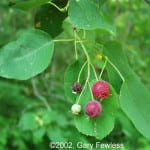If birds summering in the Western Great Lakes region have a favorite fruit, it has to be the Juneberry (Amelanchier spp.). Two weeks before the fruit were ripe our resident American Robin would make a daily visit to the trees outside my office, hop from branch to branch, cocking his head to get the best eye-full of berry. He would sample ones that had already brightened to rosy pink, sometimes dropping the fruit if it was too green. On the day the first fruit ripened, she had the tree to herself for about 3 hours before the first Cedar Waxwings arrived. At the height of the harvest on the single tree, I counted one adult Robin, three juvenile Robins, 8 Cedar Waxwings, a pair of Northern Cardinals, and one shy Grey Catbird that was immediately chased off by the Waxwings.

I usually cannot help myself, and sneak out to pick a handful of the fruit for myself. The flavor is reminiscent of blueberries, but has definite plum or dark cherry flavors as well. A serving of juneberries provides 23% of the recommended amount of iron and are high in potassium, and magnesium, vitamin C, B6, A and E. Cooking the berries improves the sweetness and flavor of the fruit, so feel free to eat that whole juneberry pie!
There are 20 named species in the genus Amelanchier (Rosaceae). There are almost as many common names to describe these shrubs and small trees including juneberry, shadbush, shadwood, shadblow, serviceberry or sarvisberry, wild pear or chuckley pear, sugarplum or wild-plum, and even chuckleberry, currant-tree, or saskatoon. In the southwest, Amelanchier denticulata is referred to as Membrillo, Membrillito, Madronillo, Cimarron, Tlaxistle, or Tlaxisqui. The common names often vary by location and many relate different phenological events together. Juneberry is obvious, and is most often used for the species that occur in the Midwest where the berries usually ripen in June, (however this year they did not ripen in Green Bay until July 2nd). Several names refer to the flavor or shape of the fruit including membrillo, which is Spanish for quince, or to location, such as Saskatoon or Cimarron. Names that include shad are derived from New England and eastern Canada, where the shrubs bloom in early spring at about the same time that Shad (fish in genus Alosa) return to rivers to spawn. Service or “Sarvis” supposedly relates back to the time of itinerant preachers that traveled in New England. The plants bloom in early spring shortly after the trails are clear of snow and the preachers were able to travel to the towns. I could find no source for chuckleberry, but it seems likely a corruption of the older chuckley pear, another name that I could find little history on.
Amelanchiers are important plants for native landscapes. These shrubs provide nectar for early emerging pollinators especially native bees and overwintering butterflies, fruit for birds, and are hosts for the larvae of several species of butterflies. The plants provide four season interest, including beautiful white flowers in early spring, berries in early summer, foliage that that turns to brilliant oranges to deep reds in fall, and beautiful vase shaped silver barked stems in the winter. There are a variety of forms available to suit most areas from small shrubs to branching specimen tree that can grow to 25 feet in height. The eastern varieties are understory shrubs that are well suited to woodland or shady areas. And if you are lucky and can beat the birds to harvest, the sweet fruit can be used in almost any recipe that calls for blueberries.
Flowers, form, and berries of Amelanchier laevis, a common serviceberry in Wisconsin and the eastern United States. Other species have similar flowers and fruit.
There is at least one species of Amelanchier that is native somewhere on mainland North America and all species are edible, so it should be possible to find a variety that will thrive in your yard. Native varieties should be available at specialty nurseries and many nurseries carry the Apple Serviceberry (Amelanchier X Grandiflora), a hybrid between Amelanchier canadensis and Amelanchier laevis that grows 15 to 25 feet tall and has large showy flowers. There are several named varieties with different growth habits, fall coloration, and disease resistance. “Autumn Brilliance” is one hybrid variety that is most readily available in the Midwest. All species are edible, although some produce more or larger fruit and new disease resistant horticultural varieties are now available that make growing these plants easy for home gardeners.
More information and Recipes
- Growing “The Amazing Serviceberry” Mother Earth News: http://www.motherearthnews.com/real-food/the-amazing-serviceberry.aspx#axzz2YaSW4hTe
- Serviceberry storage and recipes from U. of Alaska Fairbanks: http://www.uaf.edu/files/ces/publications-db/catalog/hec/FNH-00122.pdf
- Juneberry Recipes from Cooks.com: http://www.cooks.com/rec/search/0,1-0,juneberry,FF.html
- Serviceberry and poppyseed cake from Food And Style: http://foodandstyle.com/2009/06/18/serviceberry-and-poppy-seed-cake/



